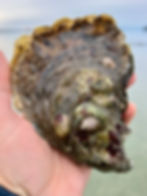- Emily Selinger
- Aug 28, 2024
August has come and gone in the blink of an eye, as it always seems to do. The weather

has been beautiful this year, temperatures have been a bit more reasonable than the blistering heat and humidity of July, making long work days on the water a lot more productive and bearable.
I've been ticking off most of the usual August projects one by one, but some things have been going a little bit differently this year, for better or worse. This later part of the season always requires lots of my energy going toward the seed, which at this point is much bigger and growing very fast. This year is no different there, and I've been doing lots of sorting by size to maximize the seed's potential and keep it organized, and dividing it up and spreading it out into more and more bags as it increases in volume to keep the individual oysters from getting overcrowded and competing for food. This year's batch of seed has developed a bit of a bigger split in growth rates than I am used to, though, which has been challenging. A good portion of the oysters grew speedily and graduated out

of the nursery boxes quickly, but there is a noticeably greater quantity of much slower growers that usual this year which continue to remain in the boxes. Every two weeks I grade thru the slow pokes and pull more of them out that are ready for the smallest mesh grow bags, but I've had nursery boxes in for much longer this year than I am used to. Fingers crossed the little ones will size up enough soon so that they are substantial enough to survive the winter.
Late summer also entails lots and lots of fouling management - this means lots of air drying and scrubbing and scraping to try and stay on top of all the slimy algae and creatures that proliferate in the warm water and make the oyster gear heavy and clogged up. One little bright spot this year, though, has been the absence of the giant mussel spawn that usually causes millions of baby mussels to settle and attach themselves onto my oysters and gear. I'm not sure why I missed that event this year, if it came earlier in the season (there was some evidence of an early spring spawn) or what, but I am grateful to have a little bit of break on the mussel management.
.png)





